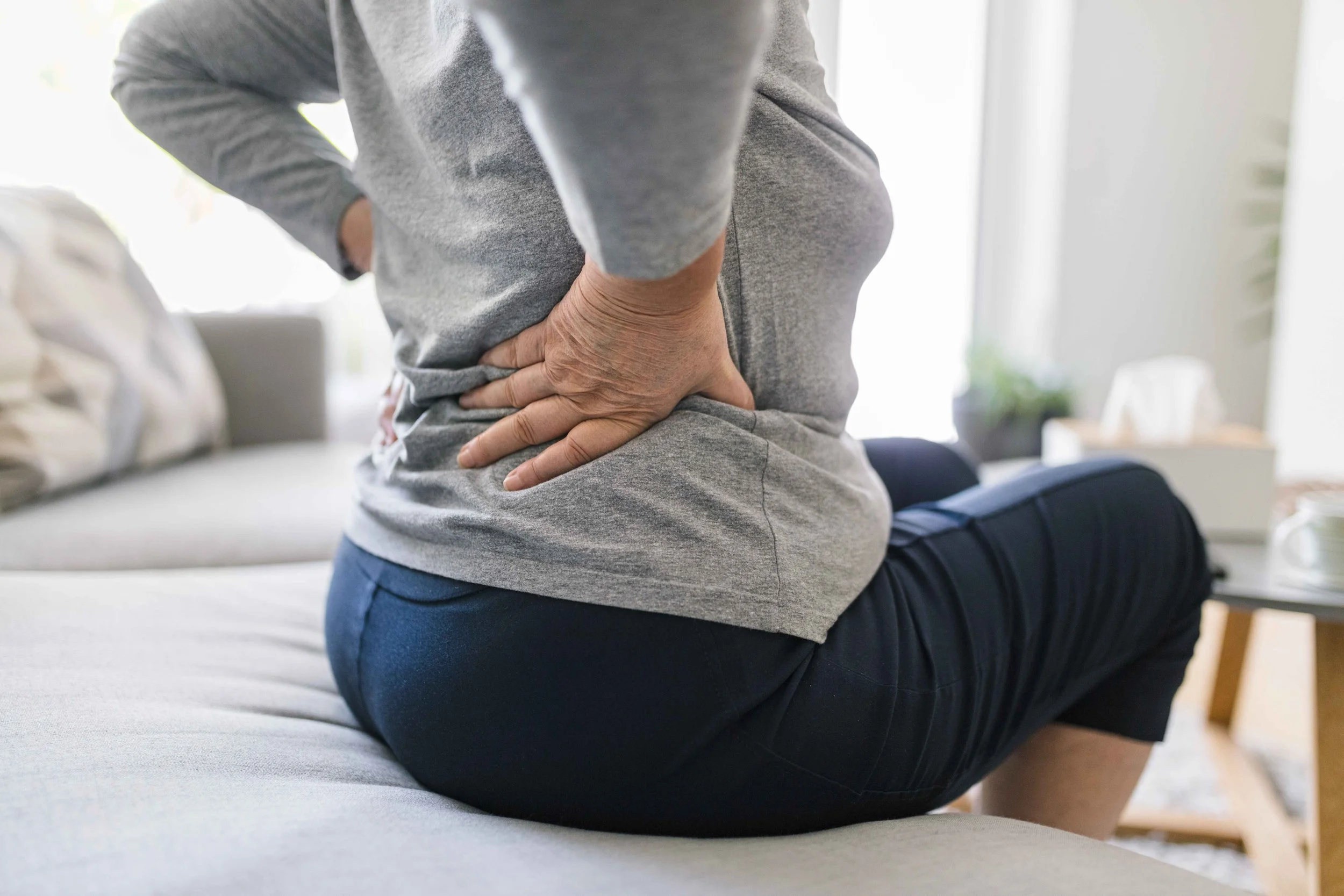SI Joint Pain Causes, Relief, and Exercises According to a Doctor
Understanding Sacroiliac Joint Pain
SI joint pain is one of the most common sources of chronic back pain and accounts for about 15 to 30% of patients presenting with chronic low back pain.
What Is the SI Joint?
The sacroiliac joint connects the crests of the hip bones to the bottom of your spine known as the sacrum. By doing so, it provides a stable yet flexile support of the upper body while distributing load from the lower extremities throughout the rest of the body.
Simply put, this joint helps keep you stable on your feet. Unlike your shoulder joint, this joint is not meant to move much, rather it is largely for stability. In fact, there are about over 40 muscles that surround this joint, including muscles of the back, hip, core, buttocks and thighs.
Where Do You Feel SI Joint Pain?
SI joint pain is often characterized by pain in the lower back or buttocks, and it may also radiate down the legs. The pain can range from mild to severe and may be aggravated by activities such as standing, walking, sitting or climbing stairs. Additionally, changes in positions, such as moving from sitting to standing or vice versa, can trigger or worsen SI joint pain.
What Are the Causes of SI Joint Pain In Adults Over 50?
Several factors can contribute to SI joint dysfunction and pain, including:
Trauma: Injuries or accidents, such as falls, weight lifting or car accidents, can affect the SI joints.
Arthritis: Inflammatory arthritis, such as ankylosing spondylitis, can affect the SI joints.
Degenerative changes: Wear and tear on the joints over time can contribute to pain.
Infection: Although this is rare, but if the joint becomes infected, there will be substantial pain
How Do You Diagnose SI Joint Pain?
Diagnosis of SI joint pain can be challenging because the symptoms can mimic other conditions, such as lumbar spine issues. A healthcare professional, often a rheumatologist, orthopedic surgeon, or a pain specialist, may use a combination of medical history, physical examination, and imaging studies (such as X-rays or MRI) to diagnose SI joint dysfunction. Unfortunately there is no gold standard in diagnosing SI joint pain. What is important is going to a health care professional if you are noticing pain that simply is not going away.
What Are the Best Ways to Treat SI Joint Pain?
There are a wide range of treatments for SI joint pain and often times the best way to approach this type of pain is a multi-modal approach. Your physician may recommend a combination of these treatments.
Rest and Activity Modification:
Resting and avoiding activities that aggravate the pain can help reduce inflammation and allow the joint to heal.
Physical Therapy:
A physical therapist can provide exercises to strengthen the muscles around the SI joint, improve flexibility, and promote better joint stability.
Physical therapy has been proven to shown both intermediate and long term benefits
Medications:
Nonsteroidal anti-inflammatory drugs (NSAIDs) like ibuprofen or naproxen can help reduce inflammation and relieve pain. It is important to take these with food as long term usage and high doses can upset your stomach.
Heat and Cold Therapy:
Applying heat or cold packs to the affected area can help reduce inflammation and ease pain. I normally recommend my patients to purchase as electronic heating pad as they can just plug it in and apply it directly to the area for consistent heat and relief.
Braces or Belts:
Wearing a sacroiliac belt or brace may provide additional support to the SI joint and help alleviate pain.
Exercises and Stretching:
Specific exercises and stretches prescribed by a healthcare professional can target the SI joint and surrounding muscles to improve strength and flexibility. These at home stretches for SI pain may help relieve your symptoms.
Massage and Manual Therapy:
Soft tissue manipulation and therapeutic massage may help relax tight muscles and improve joint mobility.
Acupuncture:
Some people find relief from SI joint pain through acupuncture.
Interventional Management Options:
If conservative management described above still is not proven to be effective, there are more aggressive measures that can pursued.
SI Joint Injections:
Corticosteroid injections directly into the SI joint can provide temporary relief from inflammation and pain. However, injections are not recommended until conservative management with physical therapy, NSAIDs, activity modification has shown to be ineffective.
Radiofrequency Ablation (RFA):
This procedure involves using heat to disrupt the nerves that transmit pain signals from the SI joint. It can provide longer-lasting relief compared to steroid injections.
Surgery
SI joint fusion has been established as a surgical method for unresolved pain. The pain relief comes from eliminating the joint space and subsequent limitation of movement from that joint.
Lifestyle Changes for SI Joint Pain Relief
Some of these treatments sound intense and overwhelming, so let’s take a moment and dive into what we can do in our day to day to better manage SI joint pain or even reduce the chance of getting it.
Weight Loss for SI Joint Pain
Risk factors for SI joint pain include obesity. The idea here is reducing weight so that there is less pressure placed on this joint on a regular basis
Exercises for SI Joint Pain
The best exercises for SI joint pain are focused around core stabilization, pelvic stability and the stretching of surrounding muscles. Some of these exercises include bridges, Cat-Cow stretch pose, clamshell stretches and planks. Find tons more joint-friendly, at-home exercises in our Mighty Health workout library.
How to Sit with SI Joint Pain
Maintaining neutral spine position when sitting is important to decrease stress on SI joint. Use chairs with good lumbar support.
How to Sleep with SI Joint Pain
Sleeping on your back can lead to more pressure on the SI joint, so consider side sleeping in a fetal position or even sleeping on your stomach to relieve that pressure
Mighty Takeaways on SI Joint Pain Causes and Treatment
SI joint is the joint that connects your hip bone to your lower spine and it is responsible for stability and distributing load to the lower extremities
SI joint pain presents like many other types of lower back pain and can manifest as aching pain in the lower back and buttocks and can even radiate down to your legs
There is no gold standard for diagnosing SI joint pain so it is important to see a health care professional if you are suffering from lower back pain without relief for more than 4 weeks
There are many treatments for SI joint pain, but start with conservative management. This includes stretching and exercising, physical therapy and NSAIDS or cold/heat therapy for pain control.
There are things in your control NOW to prevent SI joint pain such as weight loss if youre experiencing obesity, routine exercises to strengthen your core and hip muscles and stretching regularly to keep your muscles in the area flexible and loose!
Alleviate Your Pain with Mighty
Looking for accountability and consistency in your health journey? Mighty Health offers easy to follow, personalized guidance for your unique health goals. Each exercise, lesson, and nutrition plan is designed specifically for those over 50, so you can thrive in these years of your life. Try it out today for more energy, weight loss, improved balance, better mobility, reduced joint pain, and the strength and stamina to spend time with those you love.
Find more great exercise routines for healthy aging and joint mobility on our website. Download the app to match with your very own health coach, who is a real person here to guide, support, and encourage you every step of the way. We can help you regain and maintain your flexibility so you can increase your mobility, reduce pain, decrease your risk of falls, and improve your overall quality of life.





